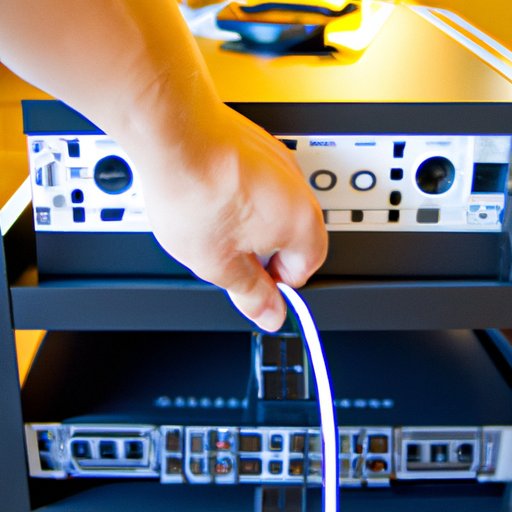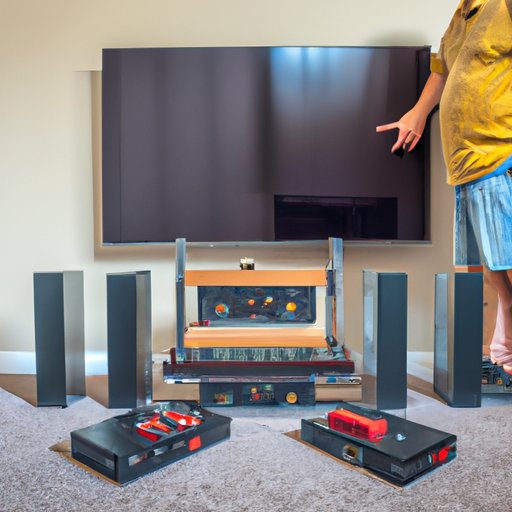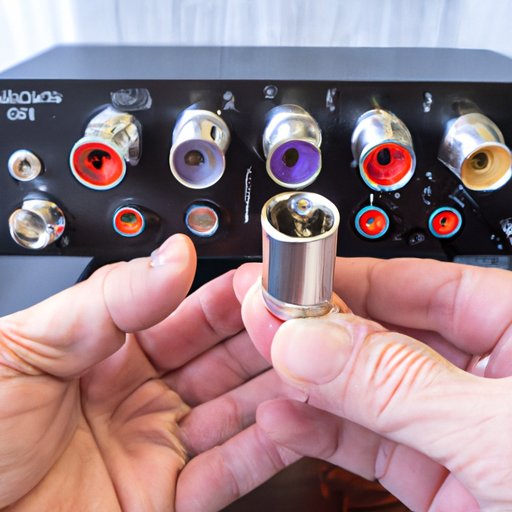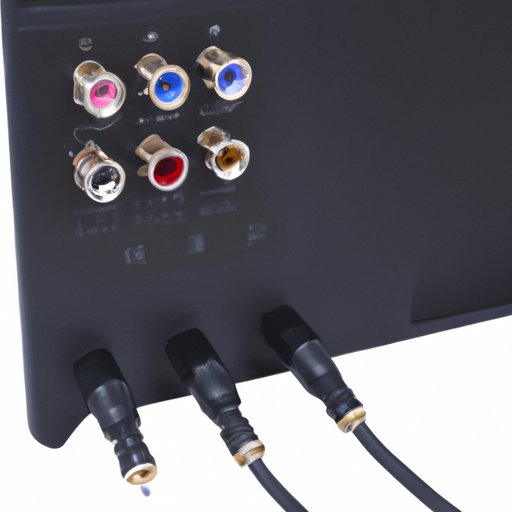Introduction
A home theater system is a great way to bring the cinema experience into your own home. Whether you’re streaming movies, playing games, or watching sports, having the right equipment can make all the difference. But before you can enjoy the full benefits of your home theater system, you need to know how to set it up correctly.
A home theater system typically consists of a television, speakers, audio/video receivers, subwoofers, and other components. Different types of connectors are used to connect these components, such as HDMI, optical, coaxial, and component cables. In this article, we will provide a comprehensive guide on how to hook up your home theater system.
Step-by-Step Guide to Connecting Your Home Theater System
Once you have all the necessary components, follow these steps to properly hook up your home theater system:
1. Unpacking and Inspecting Components
The first step is to unpack and inspect each component individually. Make sure that everything is in good condition and that all the necessary cables and accessories are included. If any components are damaged or missing, contact the manufacturer for replacement parts.
2. Connecting the Television
Next, you will need to connect your television to the other components. Depending on the type of television you have, you may need to use different types of cables. For example, if you have an LCD TV, you will likely need an HDMI cable. If you have an older model, you may need to use component or composite cables.
3. Connecting Audio Sources
Once the television is connected, you can move on to connecting the audio sources. This includes speakers, subwoofers, and audio/video receivers. You can use either digital or analog connections, depending on the type of audio source. Digital connections, such as optical and coaxial cables, provide better sound quality but require additional hardware.
4. Connecting Video Sources
The next step is to connect the video sources, such as DVD players, Blu-ray players, and gaming consoles. Again, different types of cables may be required depending on the type of video source. For example, HDMI cables are usually used for high-definition video sources, while component and composite cables are better suited for standard definition video sources.
5. Setting Up the Surround Sound System
Finally, you will need to set up the surround sound system. This involves connecting the speakers to the receiver and adjusting the settings to match the size and layout of your room. It is important to ensure that the speakers are placed at an appropriate distance from each other, as well as from the television and other components.

Tips for Setting Up a Home Theater System
When setting up a home theater system, there are several things to consider. Here are some tips to keep in mind:
Location of Speakers
The location of the speakers is very important for optimal sound quality. Ideally, the center speaker should be placed directly in front of the television, while the other speakers should be placed at an equal distance from each other in order to create a balanced sound field.
Placement of Components
The placement of the components is also important. Try to keep them away from direct sunlight and heat sources, as this can cause overheating and damage the components. Additionally, keep the components away from any sources of interference, such as wireless routers or other electronic devices.
Cable Management
Finally, it is important to keep the cables organized. This will help reduce clutter and make it easier to troubleshoot any issues that may arise in the future.

What You Need to Know Before Installing a Home Theater System
Before you start setting up your home theater system, there are a few things you should know:
Understanding Connectors
It is important to understand the different types of connectors that are used in home theater systems. The most common types are HDMI, optical, coaxial, and component. Each type has its own advantages and disadvantages, so make sure to research which one is best for your needs.
Choosing the Right Components
It is also important to choose the right components for your home theater system. Consider factors such as the size of the television, the type of speakers, and the type of audio/video receivers. Additionally, consider whether you want to add a subwoofer for extra bass.
Budget
Finally, it is important to set a budget for your home theater system. Depending on the components you choose, the cost can vary significantly. Make sure to research the various options available to find the best components within your budget.
How to Choose the Right Components for Your Home Theater
When choosing components for your home theater system, there are several factors to consider:
TV Size
The size of the television is an important factor. Generally, larger TVs provide a better viewing experience, but they may not fit in smaller rooms. Consider the size of the room and the type of content you plan to watch when choosing a TV.
Type of Speakers
The type of speakers you choose will have a big impact on the sound quality. Generally, larger speakers provide better sound, but they may not fit in smaller rooms. Consider your budget and the size of the room when choosing speakers.
Audio/Video Receivers
Audio/video receivers are used to control the sound and video from different sources. Look for models that offer features such as Dolby Atmos and 4K video support to get the most out of your home theater system.
Subwoofers
Subwoofers are optional but can greatly improve the sound quality of your home theater system. They provide extra bass and can enhance the overall sound experience.
A Beginner’s Guide to Installing a Home Theater System
Installing a home theater system can seem intimidating, but it doesn’t have to be. Here is a basic guide to help you get started:
Basic Setup Steps
The first step is to unpack and inspect all the components. Then, connect the television to the other components using the appropriate cables. Next, connect the audio sources and video sources. Finally, set up the surround sound system by connecting the speakers to the receiver and adjusting the settings.
Connecting Components
Once the components are unpacked and inspected, you will need to connect them. Depending on the type of components, you may need to use different types of cables. For example, HDMI cables are usually used for high-definition video sources, while component and composite cables are better suited for standard definition video sources.
Adjusting Settings
Once the components are connected, you will need to adjust the settings. This includes setting the correct speaker levels, adjusting the bass and treble levels, and selecting the right audio mode. Additionally, you will need to calibrate the picture settings to ensure the best possible image quality.
Troubleshooting Common Issues When Hooking Up a Home Theater System
When setting up a home theater system, it is inevitable that you will encounter some issues. Here are some of the most common problems and their solutions:
No Picture or Audio
If you don’t see a picture or hear any sound, check the connections and make sure all the cables are securely attached. Additionally, check the settings on the audio/video receiver to make sure they are set correctly.
Poor Picture Quality
If the picture quality is poor, try adjusting the picture settings on the television. Additionally, make sure the cables are securely connected and that the source is outputting the correct resolution.
Poor Audio Quality
If the audio quality is poor, make sure the speakers are connected correctly and that the audio receiver is set to the correct mode. Additionally, check the settings on the audio receiver to make sure the levels are set correctly.

Explaining the Different Connectors Used in Home Theater Systems
Different types of connectors are used to connect the components of a home theater system. Here is a brief overview of the most common types:
HDMI
HDMI is the most common type of connector used in home theater systems. It is used to connect high-definition video sources, such as Blu-ray players and gaming consoles, to the television. It is also used to connect audio/video receivers to the television.
Optical
Optical cables are used to connect digital audio sources, such as CD players and streaming devices, to the audio/video receiver. They provide better sound quality than traditional analog connections.
Coaxial
Coaxial cables are used to connect analog audio sources, such as cassette players and turntables, to the audio/video receiver. They are less common than optical cables, but they provide a reliable connection.
Component
Component cables are used to connect standard definition video sources, such as DVD players and VCRs, to the television. They are not as common as HDMI cables, but they provide a reliable connection.
Conclusion
Setting up a home theater system can seem daunting, but it doesn’t have to be. With the right components and a bit of knowledge, you can easily set up your system and enjoy the full cinematic experience in the comfort of your own home. By following the steps outlined in this guide, you will be able to confidently hook up your home theater system and get the most out of your entertainment.
(Note: Is this article not meeting your expectations? Do you have knowledge or insights to share? Unlock new opportunities and expand your reach by joining our authors team. Click Registration to join us and share your expertise with our readers.)
